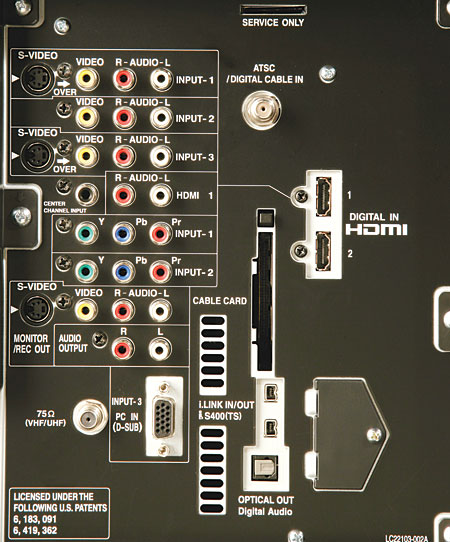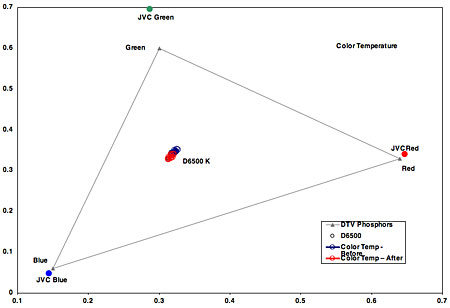The 2007 1080p RPTV Face Off JVC HD-61FN97 D-ILA HDTV
Finally, an iris.
Narrowly squeaking past the Toshiba to secure the first-runner-up spot, the JVC was this year's polarizing choice. It had one first-place vote, two for second place, and a fourth- and a fifth-place vote, as well. It all depended on what each reviewer valued—or was bothered by—the most.

Older JVC RPTVs were known for having great processing—as well as pretty terrible black levels. Thankfully, this year's models have an iris. You can adjust the iris for blistering light output, almost as much as the Samsung's—or, even better, for the second best black level in the Face Off. All the while, the contrast ratio stays high, usually in the 5,000:1-to-6,000:1 range. This is an excellent implementation of an iris, allowing the JVC to have an extremely wide range of light-output options.

The processing hasn't worsened from last year's model, either. Like only one other TV in the Face Off (the Olevia), the JVC was able to detect and process the 3:2 sequence in a 1080i signal. Few TVs on the market do this. While this is just one aspect of performance, it is an indication that someone at JVC is paying attention. The JVC is a little slow picking up the 3:2 from 480i when it's in Natural Cinema mode. The video processing is also good. There were very few jagged edges on the Silicon Optix test DVD. Scaling wasn't bad. A few judges thought that some of the other TVs were able to pull a bit more detail from 480i, but not a lot. Overall, everyone felt that the HD-61FN97 was very detailed. Adrienne, who gave this set her first-place vote, thought it made the most of its 1080p resolution.
 Color wasn't the JVC's strong suit. The Sony set was less accurate, but, interestingly, because all of the Sony's colors were off uniformly, it wasn't as objectionable. The JVC, on the other hand, had a very oversaturated green, while blue and red were less so. Because of this imbalance, several judges commented that, even though it didn't seem as oversaturated, it seemed more off. Accordingly, Nikhil ranked this set low because he didn't like the color.
Color wasn't the JVC's strong suit. The Sony set was less accurate, but, interestingly, because all of the Sony's colors were off uniformly, it wasn't as objectionable. The JVC, on the other hand, had a very oversaturated green, while blue and red were less so. Because of this imbalance, several judges commented that, even though it didn't seem as oversaturated, it seemed more off. Accordingly, Nikhil ranked this set low because he didn't like the color.
The remote, like all recent JVC remotes, has a lot of tiny, identical buttons. It's hard to navigate, but at least it's backlit. The menus, too, are the same as those found on previous models and really don't complement this TV's performance, price, or decade, for that matter. Oh, well; with any luck, you won't have to use the menus often. The Theater Pro button on the remote puts the TV in a movie mode that drops the iris and color temperature down to theater-type levels.
Without the iris, there is no doubt that this TV wouldn't have ranked this highly. With the competition so strong, this addition was a smart move for JVC. The excellent contrast ratio, black level, and processing make for a strong display. The color accuracy isn't great, but it's not as bad as that of some. Overall, JVC did a lot of things right, and the HD-61FN97 is a very highly performing runner-up. In fact, after you read about the winner, you may come back here and check this one out again.
Highlights
• Excellent processing
• Great iris
At A Glance: JVC HD-61FN97 D-ILA HDTV

Connections
Inputs:
Video: HDMI (2), component video (2), S-video (2, shared), composite video (4, 2 shared)
Audio: None
Outputs:
Video: S-video (1), composite video (1)
Audio: stereo analog (1), optical (1)
Additional: CableCARD (1), PC-RGB (1), FireWire (2), RF (2)
Features
Type: LCOS (D-ILA)
Screen Size (diagonal): 61
Native Resolution: 1080p
Lamp Life: 7,500 hours
Dimensions (H x W x D, inches): 40 x 55.4 x 19
Weight (pounds): 97
Price: $2,900
Ratings: JVC HD-61FN97 D-ILA HDTV
Build Quality: 89
Value: 90
Features: 91
Performance: 93
Ergonomics: 87
Overall Rating: 91
General Information
HD-61FN97 D-ILA HDTV, $2,900
JVC
(800) 252-5722
www.jvc.com
Dealer Locator Code JVC
HT Labs Measures: JVC HD-61FN97 D-ILA HDTV


Full-On/Full-Off Contrast Ratio—6,131:1; ANSI Contrast Ratio—182:1
Measured Resolution with the Leader LT-446:
480: 480 (per picture height)
720p: 720 (pph)
1080i: 1,080 (pph)
DC Restoration (poor, average, good, excellent): Average
Color Decoder (poor, average, good, excellent): Excellent
Measured Color Points:
Red Color Point: x=0.647, y=0.340
Green Color Point: x=0.287, y=0.696
Blue Color Point: x=0.144, y=0.048
The left chart shows the HD-61FN97's gray scale relative to its color temperature at various levels of intensity, or brightness (20 IRE is dark gray; 100 IRE is bright white). The gray scale as set by the factory, in the Low color-temperature mode and the Theater Pro picture mode, measures warm across the entire gray scale. After making adjustments using the Photo Research PR-650, the gray scale measures accurate with the darkest images but then becomes warm with the lower midtones. Midtones are slightly cool, and then drift back to warm toward the brighter images, as compared to D6500, the accurate color temperature.
The right chart shows the gray scale (or color temperature) relative to the color points of the display's red, green, and blue LCOS panels. These are somewhat off those specified by SMPTE. Red is slightly oversaturated and slightly reddish-orange. Blue is slightly oversaturated. Green is very oversaturated.
After calibration, and using a full-field 100-IRE white (98.09 foot-lamberts) and a full-field 0-IRE black (0.016 ft-L), the contrast ratio was 6,131:1. Using a 16-box checkerboard pattern (ANSI contrast), the contrast ratio was 182:1. The best contrast ratio was achieved in the –10 iris setting. The brightest image was achieved in the +10 iris setting and produced 161.5 ft-L with a 100-IRE white and 0.048 ft-L with a 0-IRE black, which makes for a contrast ratio of 3,365:1.—GM
- Log in or register to post comments






























































